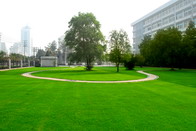Invited by State Key Laboratory of Geodesy and Earth’s Dynamics (SKLGED), prof. Jeffrey T. Freymueller from University of Alaska visited Institute of Geodesy and Geophysics(IGG) and gave an academic report in title “Megathrust Slip in Alaska in Space and Time” on Mar 21.
The report firstly introduced that in the subduction zone environment often catastrophic earthquakes, most of which will affect the thrust of the thrust fault. The report gave a detailed introduction to the slip characteristics of Alaska's large thrust faults throughout the seismic cycle, highlighting the very variable nature of slippage in both time and space. Slow sliding events have been observed for many years in the downward dip direction of the 1964 fracture of Cook Bay. It is speculated that the transition along the strike slip in some cases may be related to the measured attribute changes of the plate interface, but the underlying cause remains uncertain. The report showed the research results of years of research by prof. Jeffrey and his team. During the discussion session, audiences and prof. Jeffrey conducted in-depth discussions and achieved good exchange results.
Prof. Jeffrey received his bachelor degree from the California Institute of Technology in 1985, and received his master and doctor degree from the University of South Carolina in 1988 and 1991 respectively. He has been working at the Institute of Geophysics, University of Alaska since 1995. Prof. Jeffrey is mainly research in solid earth sciences and he has published more than 110 papers in journals such as Nature, Science, JGR, and GRL. He has served as chair of geodesy of the American Earth Society (AGU), chairman of the UNAVCO Steering Committee, and deputy editor of the international journal JGR-SOLID.

